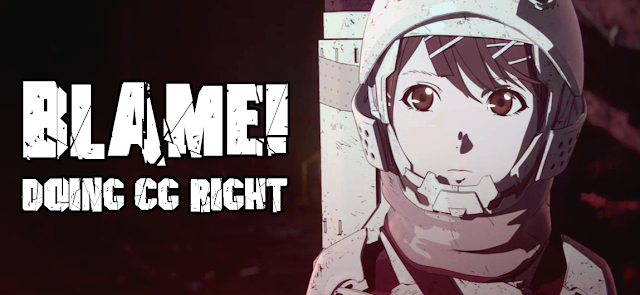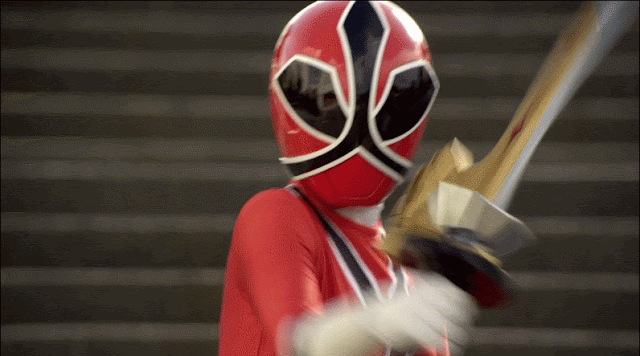Blame! - Doing 3DCG The Right Way
The post-post-apocalypse looks breathtaking.
Most anime are, naturally, rendered in 2D. When 3DCG elements are used, they're usually there for cost-saving measures. It's easier and quicker - not to mention cheaper - to animate a giant robot using a cel shaded three-dimensional model than to animate it by hand. Most of the time, this ends up making the entire affair look like two different shows. The 3D parts of an anime are so clearly distinct from the traditionally animated segments (which would make up most of the show) that visual whiplash is almost ensured. I say "almost" because some anime are actually quite good at blending their two sides together, mostly extremely high-quality OVA's or movies are capable of pulling it off, usually Gundam in the cases of Gundam Thunderbolt and Gundam: The Origin. However, you'll occasionally run into an anime that goes full-bore into 3D and the results are usually mixed, as with Knights of Sidonia. The feature film for Blame! meanwhile doesn't have this problem.
Of course, Blame! is a movie that is almost required to be visually arresting if it is to work. Much of the notability of its manga source material hinges on its incredibly detailed backgrounds and designs. Many of these designs are bizarre and have a variety of moving parts, which means one has to give Tsutomu Nihei a commendation for being able to pull off these designs on black-and-white pages. Doing all of this in a traditionally animated anime would be incredibly difficult, with the manga infamously declared unadaptable due to its distinct visual style. However, doing so in 3D managed not only to mitigate those concerns, but showcase the post-apocalyptic that Nihei had so painstakingly created.
The main setting of Blame! is the City, a never-ending collection of buildings created in a nonsensical pattern across what is presumably the underground and surface of Earth, though the vastness of the place makes one doubt that. The City is not built by humans, but instead by the Builders, giant machines that have, endlessly, continued to expand the City because of a logic flaw in their programming. Because it is a machine-built world, the City looks absolutely alien. Almost clinical in its design, the City looks like an eternity of jagged lines, ventilation shafts, electrical wiring, and so on. Because Blame! is primarily animated using 3D, that means that the detail work on these static backgrounds can be as intense as possible, with shots that last for seconds having so much in them that every frame could be a work of art on its own. Gigantic empty spaces, decrepit sectors long forgotten by the machines, everything looks breathtaking in its own alien way.
Of course, backgrounds are sometimes rendered in 3D, a necessity if one were to portray a 3D object or character properly interacting with it. Most notably, there is a scene quite early on when a character falls from a great height down the seemingly bottomless levels of the City. They tumble to and fro, hitting various bridges and piping in a sustained shot that follows them downward. The breadth of the sequence shows just how massive even just this tiny section of the City is. Another plus of using 3D is it allows them to use quite a bit of real-time postprocessing, which means that things like lighting and shadow-work are done by the asset engine as opposed to having to be drawn in. Thus, the film's lighting not only looks fantastic but completely natural - but because everything is modifiable, it can also look startlingly otherworldly when it needs to be. The best part of all this, naturally, is how the film manages to tell a story just by its backgrounds. There are moments of little dialogue when the characters are just traversing through the maze-like interior that allows the audience to take in the magnitude of their world.
Something else that must be seen to appreciate it is this film's ability to faithfully translate 2D character designs into 3D. Often in 3D animated adaptation, one will run afoul of odd-looking characters who don't look nearly as good in three dimensions as they did in two. This is thankfully not the case in Blame! where everyone looks like they have just walked into a different dimension. Indeed, it appears more like a science fiction post-apocalyptic version of a Tales game, which have exquisite cel shaded animation. Take, for example, Zuru - ostensible main character of this film - who looks about as good as a character can look in 3D while still maintaining that traditionally anime style, even better in some ways. Her hair has actual physics which means that they move realistically in response to interaction with objects, while her face looks to have its own rigging parameters so its various features can display a wide array of emotions. She looks beautiful, and one can stare at her face and be entertained just by its intricacies.
Of course, Blame! is also an action movie, and so its action sequences - while not numerous - are impressive in their own way. Taking full advantage of being rendered in three dimensions using object models, the film is able to be efficient by reusing and multiplying assets for multiple enemies - particularly useful because many of the robotic opponents attack the main characters in a swarm-like fashion. Their strange geometry is also a good fit for the 3D as they bend and spin and crawl in ways that would be difficult to get across in 2D. As well, object interaction is well-done as the spike-launchers that the heroes use show visible damage in the environment and the enemies, creating gaping holes and spilling robot blood all over the place. There are also some very inventive cinematographic techniques used during these sequences that would be very tricky to pull off in a traditionally animated movie, especially in the final battle that has a bare-knuckle brawl between two androids that features quite a large number of closeups.
Blame! is a beautiful move that manages to near-perfectly toe the line between a traditionally animated movie and its utilization of 3DCG with maximum breadth and efficiency; if there is a lesson to be learned from Blame! for anime going forward, it's to keep its technical achievements in mind for future 3DCG anime, especially its methods for translating 2D designs into three dimensions. If nothing else, Blame! makes me very excited to see more 3D anime created in this style.





Comments
Post a Comment